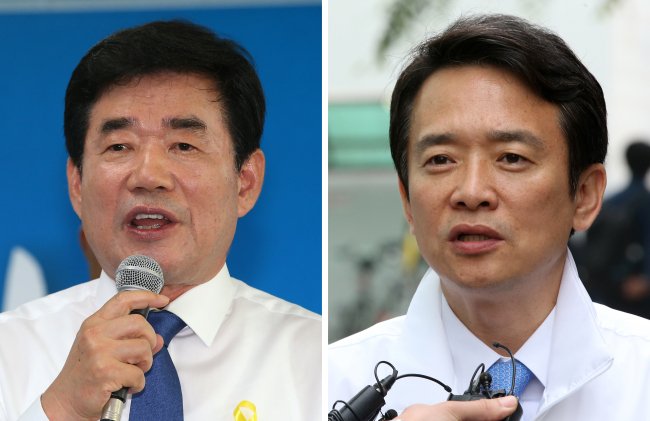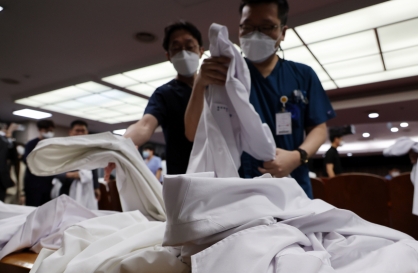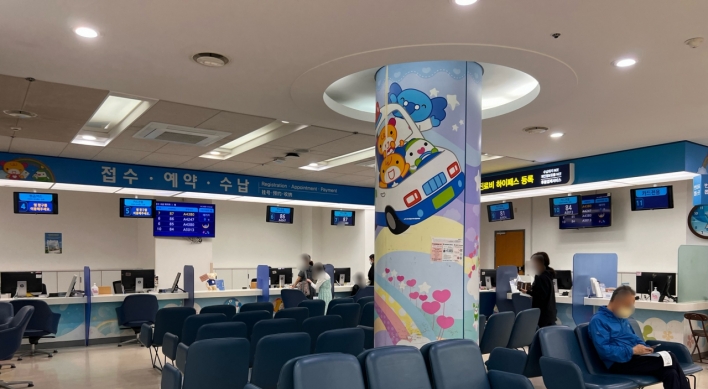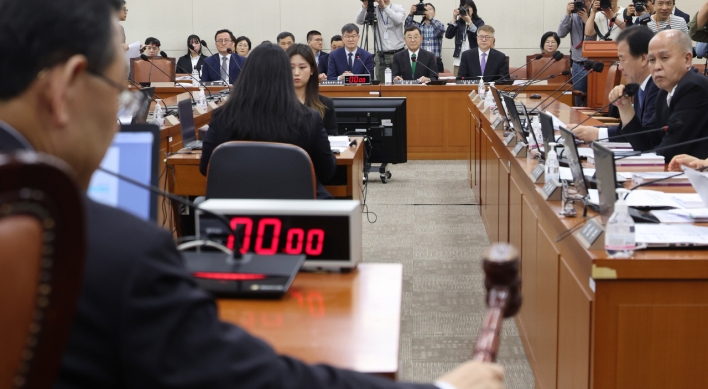This is the second installment in a series of articles on the upcoming local elections, exploring key issues and candidates in major cities. ― Ed.
Election season officially began in Gyeonggi Province on Thursday, with the top contenders for the governorship kicking off their campaigns in the capital of Suwon.
The ruling Saenuri Party’s candidate Nam Kyung-pil launched his campaign by greeting commuters at Suwon Station. Occasional rush-hour workers stopped to shake hands and take photos with Nam as reporters and cameramen recorded the scene.
Kim Jin-pyo, the main opposition New Politics Alliance for Democracy’s candidate, visited an elementary school in southern Suwon with NPAD cochairman Rep. Ahn Cheol-soo to talk about student safety.
Election season officially began in Gyeonggi Province on Thursday, with the top contenders for the governorship kicking off their campaigns in the capital of Suwon.
The ruling Saenuri Party’s candidate Nam Kyung-pil launched his campaign by greeting commuters at Suwon Station. Occasional rush-hour workers stopped to shake hands and take photos with Nam as reporters and cameramen recorded the scene.
Kim Jin-pyo, the main opposition New Politics Alliance for Democracy’s candidate, visited an elementary school in southern Suwon with NPAD cochairman Rep. Ahn Cheol-soo to talk about student safety.

Nam and Kim’s similarities are far-reaching. Both are Suwon natives and graduates of the same high school. They even go to the same church where Nam sings for the choir and Kim is an elder. Their political colors are also similar with Nam standing in the center-right and Kim considered a centrist. Nam and Kim are both stressing safety and economic growth in their campaign pledges ever since the Sewol accident hit the Gyeonggi industrial town of Ansan by killing more than 240 students from the city.
The two governor hopefuls are also seasoned politicians. Nam is a five-time lawmaker and former deputy floor leader. Kim is a former Cabinet member of the Roh Moo-hyun administration and a three-time lawmaker.
“If we could have it our way, I think many of us would like to vote for both of them,” said one voter walking to work on Thursday morning in downtown Suwon. “We love them both.”
“I wish Nam had stayed in Seoul,” said a Suwon cab driver. “Our votes might have been easier if he had stayed in the big leagues in Seoul.”
Opinion polls show that the two candidates are in for a close match. Although Nam led Kim by a comfortable margin before the Sewol ferry disaster last month, the latest poll by Media Research in mid-May showed Nam having a 40.2 percent voter approval rating and Kim with 39.4 percent.
“But do not wholly trust the opinion polls,” said Choi Young-jin, professor of Korean politics at Chung-Ang University.
“Opinion polls sometimes miss the hidden voters who don’t tell surveyors which party they support. Don’t be surprised if there are a lot of hidden Saenuri Party supporters despite the Sewol accident.”
The strong social fury against the government’s handling of the maritime disaster probably compelled many government endorsers to be quiet, Choi said.
The biggest factor will be what Ahn Dae-hee, the newly chosen prime minister nominee, and the government do to deal with the Sewol tragedy’s aftermath, he added.
Gyeonggi Province’s importance in the June local elections is critical because it is considered a mini-presidential race.
Not only is Gyeonggi the most populous province with 12 million residents, the main points of Gyeonggi elections overlap with those in Korea’s presidential races. The province’s proximity to the North Korean border induces voters to consider national security policies and unification issues alongside local problems.
“Gyeonggi Province is the geopolitical center of Korea,” Choi said.
Winning the Gyeonggi elections is sometimes regarded as a stepping stone to the presidency. Kim Moon-soo, the current governor, ran for the presidency in the 2012 Saenuri Party primary against then-candidate Park Geun-hye.
NPAD senior adviser Sohn Hak-kyu, Gyeonggi Province’s governor from 2002 to 2006, was also a presidential hopeful, having run against NPAD Rep. Moon Jae-in in 2012 for the Democratic United Party’s presidential ticket.
By Jeong Hunny (hj257@heraldcorp.com)
-
Articles by Korea Herald





![[Grace Kao] Hybe vs. Ador: Inspiration, imitation and plagiarism](http://res.heraldm.com/phpwas/restmb_idxmake.php?idx=644&simg=/content/image/2024/04/28/20240428050220_0.jpg&u=)
![[Herald Interview] Mom’s Touch seeks to replicate success in Japan](http://res.heraldm.com/phpwas/restmb_idxmake.php?idx=644&simg=/content/image/2024/04/29/20240429050568_0.jpg&u=)


![[News Focus] Lee tells Yoon that he has governed without political dialogue](http://res.heraldm.com/phpwas/restmb_idxmake.php?idx=644&simg=/content/image/2024/04/29/20240429050696_0.jpg&u=20240429210658)









![[Today’s K-pop] Seventeen sets sales record with best-of album](http://res.heraldm.com/phpwas/restmb_idxmake.php?idx=642&simg=/content/image/2024/04/30/20240430050818_0.jpg&u=)